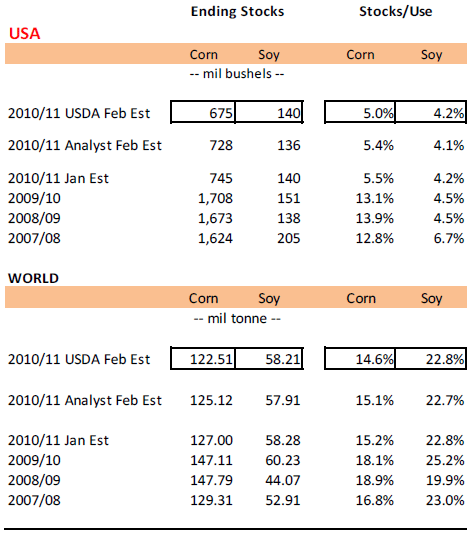



CME: Grain Markets Worry Livestock, Poultry Farmers
US - Grain markets have become a primary concern for livestock and poultry producers and that concern will only be heightened following the latest USDA estimates of US grain supplies for the current marketing year, write Steve Meyer and Len Steiner.There was plenty of anticipation coming in this latest report. Normally the February update contains few changes, mostly focused on the demand side of the balance sheet. Prior to the report, a survey of analysts conducted by Reuters showed that on average they expected ending stocks for corn to drift lower to just 728 million bushels, or 5.4 per cent of total use for the marketing year. The USDA number came in on the low end of estimates at a mere 675 million bushels. The stock to use ratio now stands at just 5 per cent, often considered as the bare minimum pipeline supplies and matching the all time low stocks to use ratio set in 1995/96. World corn ending stocks were also expected to be lower than previous forecasts, pegged at 125 million MT, 2 million MT lower than the USDA January forecasts. The USDA estimate of world supplies also came in on the low end of trade estimates at a mere 122.5 million metric ton, a 4.5 million metric ton reduction from the January estimate and now a whopping 24.6 million MT decline (-16.7 per cent) compared to 2009/10 levels.

The latest USDA numbers provided further confirmation that both US and global feed supplies remain particularly tight, with the stocks to use ratio now matching the lowest point of the last 15 years Indeed, one can argue that the current corn supply situation is in a far worse state than it was in the mid 1990s. Back then, corn prices rose sharply during the summer months in order to ration out demand. However, producers responded to the sharp price increase by boosting plantings and once the new crop came in, prices quickly reverted back to trend (which back then meant $2.5/bu. corn). This year, corn acres are expected to increase (our current working estimate is ~92 mil bu.) but that may not be enough to address the supply/demand imbalance.
Beginning stocks for the 2011/12 marketing year are going to be some of the tightest on record and we will need record yields to bring projected ending stocks above the 1 billion bushel mark. Some early analysis, however, indicates that given dry weather patterns, it will be difficult to get corn yields above 160 bu/acre. Due to current tight stocks, expected strong export demand from China and other markets, and ongoing strong ethanol demand, yields below 160 bu./acre could require further demand rationing. Indeed, the main difference between 1995/96 is the entry of ethanol, which currently accounts for more than 1/3 of total US corn use. It became quickly apparent this year that corn prices in the $5- 6/bu range would start rationing out livestock feed demand but they had little impact on ethanol. Tthe main reason for the decline in projected ending stocks is because USDA further increased projected ethanol use by 50 million bushels. High sugar cane and crude oil prices have limited the availability of Brazil ethanol and US ethanol exports to Canada and the EU have surged higher. Also, current blending margins remain positive despite high corn prices.








